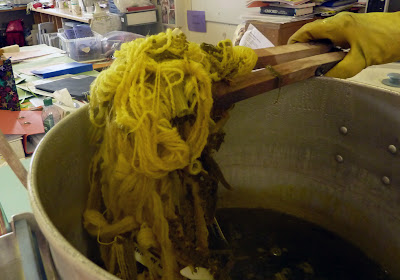For your enjoyment (and so that I remember too)....
Preparation 40.... er, after reading again only 20 were needed... 5g skeins of yarn. I used the left over handspun from my Professoressa as I wanted to see what happened with the dyes and a different natural colour yarn.
Kit needed for protection etc.
We started the day by labelling all our skeins, weighing them all together and then they were placed into the mordant baths while we got to play with some dye extracts on a sample. We then decorated a pre-mordantant cotton bag at this table which was quickly prepared.
Equipment to the left and creativity abounding elsewhere.
Works in progress.
The bags all ready to be adorned
and hanging out to dry later. Unfortunately I did not get to photograph them all and there were some wonderful works of art.
The mordant pot was simmering and preparing the skeins gently.
When it was ready Jane removed the skeins and rinsed them
and they were taken outside where Ann and Dawn placed them in the spin dryer to remove excess water.
We reclaimed our skeins. Around the room there were a number of different dye pots and we placed our labelled skeins together at each allotted pot. Mine are the grey ones on the right. This is the cocheneal pot.
Here are more collected skeins for a weld dye pot and a madder dye pot.
There was indigo too!
All kinds of vegetable matter was chopped up and made into lovely dye in dye pots. I think this was the Dyers Greenweed but honestly, I can't remember.
Once it was all ready the skeins were popped into the pots to dye.
Dyers Greenweed
The photo underneath shows what they looked like when they came out, when I was around to capture it.
Madder
Weld
Acacia
Logwood
Here is a brief summary of the process. The skeins are placed and left in the cochineal pots to dye.
Then they are removed
and washed and spun dry.
The skeins were spread on the table for us to collect for further dipping if we chose.
There are the cochineal, dyers greenweed and weld.
Judy dipped a cochineal skein into the indigo
and then she dipped a weld skein into the indigo
and then I got so excited by all the different options on offer that I am afraid the photography got forgotten but cameras and rubber gloves and liquid are also not a good mixture.
Every one was very excited about the indigo pot and gathered around to check their dips.
At the end of the day, I did go around and take some photos of the the completed skeins as they were laid out on the tables.
These skeins are tencel and yarn
These are mine.
At the end of a lovely day, I had a bag with herds of elephants and stars in all the different sample extracts
and a row of lovely colourful skeins.













































I should have joined it as well ..would have loved to achieve such a nice red from the cochineal x
ReplyDeleteIt was a fab day, Ilana, and I did think of you a lot. x
DeleteSuch beautiful images, what a great day you all had. I'm booking onto this next year!
ReplyDeleteI love that cochineal one dipped into the indigo, what a lovely colour.
Glad you had great fun!
Dawn, it was such fun to see what happened to the different skeins in the different dips. Judy was fantastic.
DeleteWow, now that looks intense but so much fun! I love how every photo you posted ~ what a wonderful adventure :)
ReplyDeleteA great adventure
Delete